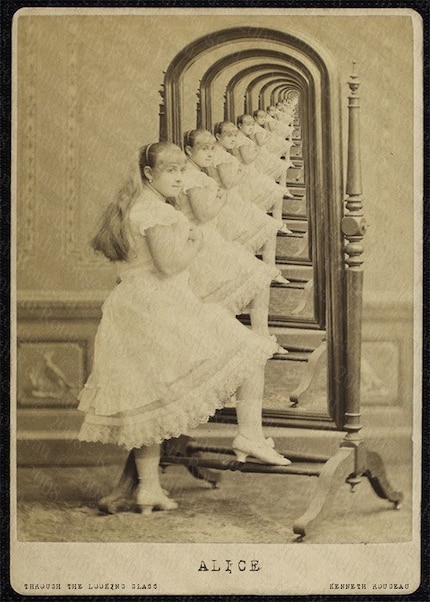The Yellow Brick Road from 'The Wizard of Oz' 1939 - Technicolour
'Alice Through the Looking Glass' by Kenneth Rougeau
This seemingly old image is actually modern. Rougeau has created a Droste effect - a particular type of repetitive image. It depicts 'Alice' from Lewis Carol's 'Through the Looking-Glass, and What Alice Found There' (1971). Alice goes through the mirror into a fantasy world populated by peculiar anthropomorphic creatures. This image create the illusion that it is infinite.
Bridget Riley came to prominence in the 1960's during the Op Art movement. Riley counts Paul Klee amongst her influences and recently arranged a show at the Hayward Gallery. Her images create a dizzying optical effect and create the illusion of movement. All an image is, is pigment on a surface and these images by Riley a flat black lines on canvas. However, they seem to move, rotate and can not be look at too long. Riley used Rhythm and Repetition to create her work and knew that a simple line is transformed when repeated.
Robert Frank 'U.S. 285, New Mexico'1956.
Here is that Iconic image again, this time it is by Robert Frank. We travel to see the world, we wouldn't think about going on holiday in your own town. This is because we are used to our surrounding - a good artist can see the most mundane things with fresh eyes. It took a Photographer from Switzerland to create the definitive images of America. From 1955 to 1956, with a fellowship from the Guggenheim to assist him financially, Robert Frank set out on a tour of the United States. There was no apparent plan - just to compile a photographic record of his travels. It was the 1950's Jazz, Abstract Expressionism, Beatniks and Jack Kerouac's "On the Road".
Robert Frank 'The Americans' 1955 to 1956
These images were released as 'The Americans' (1959). Some people have argued that the photo book is the ideal way to view photographs not the gallery wall. This is because it is more intimate and can guide you through in a certain order with subtle juxtapositions. 'The Americans' was Frank's silent journey through America. His images seemed like snap shots, poorly cropped, shot from the hip - like the visual equivilant of a beat poet or Jazz music. Like the rhythm of music certain motifs reappeared. The motif of a Jukebox helps makes the silence of photography feel like a sudden loss of hearing.
Another Motif is the grid like pattern of the flag. However, it is always shown as an object amongst objects.
Robert Frank 'The Americans'
Jasper Johns 'Flag' 1954 -55
Jasper John 'Flag' detail
This is a Flag. And it is an object. It is also a painting of a flag by Jasper Johns. Johns early work could be all three - an object, a thing and a painting of a thing. Like Frank's use of flag as an object in the real world John's work shows how images can be more than one thing. Along with Robert Rauschenberg, John's work was the bridge between the painterly marks of abstract expressionism and the everyday world of Pop Art. To create the 'Flag' he used newspaper dipped in coloured wax - known as encaustic.
Walker Evans 'Subway Portraits'
He was one of the pioneers of photojournalism, using his camera to record life on London's streets in the 1870s. As a society photographer he also captured the rich and famous in the years before the First World War




















